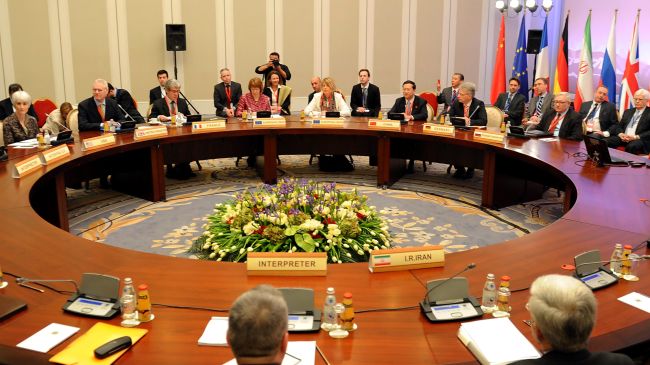Speaking after the signing of the interim agreement negotiated between the P5+1 and Iran on the latter’s nuclear program, Russian Foreign Minister Sergei Lavrov stated that, if implemented, the agreement should lead to a “revision” of plans for ballistic missile defence (BMD) in Europe. Gone would be the “premise” for an anti-missile shield in the region, said Lavrov.
Iran’s ballistic missile capabilities were not part of the interim agreement — and they may not even form part of the comprehensive talks. The interim agreement arrived at in Geneva last November consisted of provisions relating to uranium enrichment, not ballistic missile technology. According to reports, U.S. negotiators are calling for comprehensive talks to include limits on Iranian ballistic missiles, invoking UN Security Council resolutions that call on Iran to suspend ballistic missile tests until it is clear the country’s nuclear program is not designed to deploy atomic warheads. Tehran opposes any limits imposed on ballistic missiles, claiming the talks relate to the nuclear program and not to delivery systems.
Tehran is likely to stand firm on the issue. As Trita Parsi, President of the National Iranian American Council, relates in Treacherous Alliance, the experience of Iraqi Scud bombardment during the 1980-88 Iran-Iraq War convinced the Iranians of the strategic importance of a robust indigenous missile capability. Having made concessions on uranium enrichment despite opposition from conservative elements in Iran, Tehran is not likely to be open to accepting limitations on a capability that also provides the country with a conventional military deterrent.
Even if negotiations with Iran manage to secure some sort of agreement that limits ballistic missile technology, NATO has made clear that BMD is a capability that extends beyond a countermeasure to Iran’s arsenal. At the Lisbon Summit in 2010, NATO heads of state and government endorsed territorial missile defence as a dimension of the Alliance’s core task of collective defence. Iran’s missile capabilities, particularly the medium-range Shahab-3, likely factored into the threat assessments that influenced NATO thinking on missile defence. Nevertheless, NATO officially conceives of the dangers missiles and delivery systems pose as much wider proliferation threats resulting from the spread of missile technology internationally. The Alliance claims that over thirty countries possess or are seeking to develop missile technology. The NATO Information Office in Moscow reiterated this position in response to Lavrov’s statement. Modifying BMD, therefore, would be interpreted as a political reversal that could have implications for NATO’s Strategic Concept. A revised BMD program following a nuclear deal with Tehran would suggest that, beyond Iran, the proliferation of ballistic missiles is not a threat to NATO member countries.
A change of course is, however, not inconceivable. The Obama administration has already made modifications to the American component of the BMD architecture in Eastern Europe. First, in September 2009, following the Ballistic Missile Defense Review, the White House abandoned the Bush administration’s planned Ground-Based Mid-Course defence system in favour of the European Phased Adaptive Approach (EPAA), a plan that did not include the deployment of interceptors capable of countering intercontinental ballistic missiles (ICBMs) until the implementation of Phase IV in 2020. Then in March 2011, the Obama administration cancelled Phase IV of the EPAA to address Russian concerns about the anti-ICBM potential of the EPAA, which means that the now truncated anti-missile shield will only possess the capability to destroy short-, medium- and intermediate-range ballistic missiles (IRBMs).
Any decision to further alter the EPAA would take place in a deteriorating climate in European missile politics, an atmosphere that may make EPAA modifications politically difficult for Washington vis-à-vis NATO allies, particularly member countries in Eastern Europe. First, the Russian military has reportedly deployed nuclear-capable Iskander-M ballistic missiles (NATO reporting name: SS-26 Stone) in Kaliningrad, the Baltic exclave bordering Poland and Lithuania. These reports prompted NATO’s Secretary-General Anders Fogh Rasmussen to publicly deplore the deployment of offensive weapons after Poland and Lithuania expressed concerns about the missiles.
Beyond the Iskanders, the U.S. has expressed concerns about what it claims are Russian breaches of the 1987 Intermediate-Range Nuclear Forces Treaty (INF Treaty). The U.S. government recently briefed NATO member countries on potential Russian violations of the INF Treaty provisions against ground-launched IRBMs and cruise missiles in the INF Treaty’s area of application. U.S. officials claim Russia conducted flight tests of a medium-range cruise missile — reportedly a GLCM variant of the Iskander.
Even if BMD were to be pared down in the name of a P5+1 agreement, it is not certain that Russian concerns about U.S and NATO designs in Eastern Europe would be allayed. Moscow’s anxieties about NATO are only partially about missile defence; they are symptomatic of broader Russian concerns relating to NATO expansion. As the tension in Ukraine demonstrates, those anxieties extend beyond NATO to include Western European and Euro-Atlantic institutions’ political and economic influence in former Soviet space.
Taken together, these events and other developments in the region, most notably the political turmoil in Ukraine, will make a scaling back of BMD unlikely. An agreement on Iran’s nuclear program most likely would not, as far as NATO is concerned, remove the security considerations that underpin BMD – even if Tehran were convinced to accept some sort of limits on its missile arsenal. What is more, the tension between Moscow and the Western powers over Ukraine guarantees that BMD will assume an even greater symbolic value than was the case before the contest over Kyiv.





